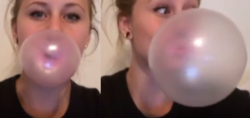Bubble Gum
 If the diameter of her bubble doubles, what happens to the thickness of the bubble's skin?
If the diameter of her bubble doubles, what happens to the thickness of the bubble's skin?
Assume that the bubbles are spheres and that the thickness of the gummy-skin is uniform.
This section requires Javascript.
You are seeing this because something didn't load right. We suggest you, (a) try
refreshing the page, (b) enabling javascript if it is disabled on your browser and,
finally, (c)
loading the
non-javascript version of this page
. We're sorry about the hassle.
The Surface Area of a Sphere is 4 π r 2 . When the diameter doubles, the radius doubles, so the surface area quadruples, since 2 2 = 4 .
Since there is a constant amount of gum equally distributed over the surface area, when the surface area quadruples, the thickness of the gum will be quartered.